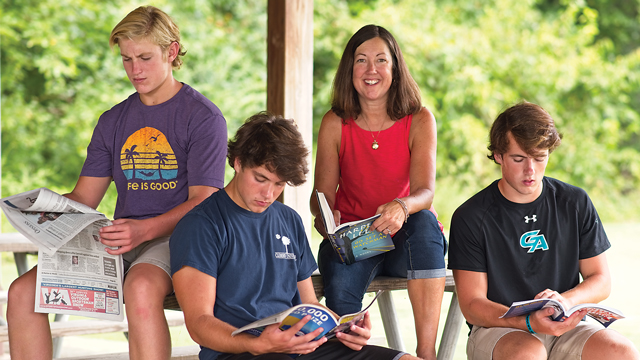
Passing on this love of fiction has been a highlight of motherhood. From lap-sitters listening to No More Jumping on the Bed to car passengers clutching the latest Magic Treehouse installment, stories have shaped my children. Their lives bear the imprints of Harry Potter and Percy Jackson and their enduring companionship. Even today, my teenage kids lose themselves in worthy tales.
Alas, there are other types of text to tackle. As an educator, I see many kids struggle with reading once it moves away from a narrative structure. Some readers can become reluctant in the absence of characters, setting, and plot. Since reading habits are formed at home, here are five text suggestions to battle the nonfiction balk.
Newspapers
Do not declare this relic extinct. It is determined to stay relevant, proving itself anew each day. Our own Richmond Times-Dispatch’s
sections are as varied as any family, with something for everyone. I offer it as a lure to attract sleepy teens, “You should see what the weather section says about this weekend…” or an enticement for the curious: “Come see what Woody predicts about the NBA playoffs…” There are opinions, reactions, and reports. A quick stop at the kitchen table keeps us current. My budding statistician gets his numbers fix while I peruse event calendars for promising outings. The Daily Jumble completes Grandpa’s morning ritual, while the rest of us test our mental reflexes spotting the differences in Friday’s Hocus Focus. There’s something for everyone in the newspaper.
Magazines
These are special-order, made-for-you, grab-at-the-grocery-store, and you’ve-got-mail reading opportunities. At our house, I read RFM cover to cover, of course, and I clip recipes and renovation ideas from Southern Living, while my better half dog-ears investment strategies in money magazines. The kids enjoyed years of scouring the hidden pictures in Highlights, delving into the science of Ranger Rick, and calling dibs on trading cards in Sports Illustrated for Kids. As hobbies and interests have changed, so has our subscription list. Periodical literature has the added bonus of addressing many components of the VA Standards of Learning (SOLs) that fiction cannot. The SOLs emphasize “text features” that are in vast supply in magazines – headlines, tables, graphs, and maps. Within the context of a hobby or sport magazine, these features fascinate.
Recipes
As some of the first practical reading material children encounter, recipes are an integral part of a text-rich home. Whether the recipes are on decades-old, vanilla-stained 3×5 cards or on a smartphone open to allrecipes.com, the text is there to treasure. My family makes Pepperidge Farm rolls together every year for Thanksgiving morning, and despite years of practice, we still consult the familiar cookbook to confirm what we know. With recipes, parents and children can delight in reading together and following steps (in lieu of a story’s rising action). And there are cross-curricular connections, of course. Recipes require measurements and fractions; that’s math in action. Directions are rich with vocabulary, including the SOL-revered multiple meaning words (think fold, poach, blanch). And of course, the conclusion of every recipe offers its own edible reward.
Instruction Manuals
Every home with children contains instructions for assembly. Every bike, scooter, lava lamp, robot, and play set comes with its own
literature. Too often, my husband and I ignored the teachable moments and opted instead for the ta-da moment inspired by the assembled gift. We (read: he) would stay up until the wee hours before holidays and birthdays, dutifully following the instruction manual du jour. I remember a particularly taxing wagon axel, but the kids were none the wiser. They adored the wagon, but they did not see the reading project that preceded it. Our backyard play set was a different story. Everyone got in on that. We (again, he) assembled it gradually, and soon the kids, their friends, and the neighbors would inquire, “What step are you on now?” There were over one hundred steps – a labor of love. The kids were the bolt sorters, I was the hammer passer, and we cherished our long-term reading assignment. Parents, I recommend foregoing the ta-da moment! Tackle an instruction manual group-read sometime soon.
Letters and Emails
In this text-savvy culture, it’s helpful for kids to see correspondence that employs standard English. I am grateful that my parents made a habit of writing to my children. They have sent letters, thank-you notes, birthday cards, and postcards from their travels. The postcards are a window to the world, and every note is a nod to a passing era. Emails are available in greater supply than letters, and many are worthy reads. Kids enjoy coaches’ introductory emails, teachers’ responses to questions, neighbors’ notes about upcoming events. Each author crafts his message with care, and readers must work to discern point of view and tone (look out—SOL prep). I seem to recall a teacher email with reference to a behavior concern that I shared with the child in question. He read between the lines with ease and was quick to confess, “Yeah, I talk too much in that class. . . ” (a study in inferences). And yes, he adjusted his behavior.
Stories are still supreme for me, but I am trying not to ignore the wealth of nonfiction that seamlessly appears on my driveway, in my mailbox, and in my inbox. This is material worthy of sharing. Kids of all ages will benefit from the exposure, and they might even enjoy the read.
Photo: Scott Schwartzkopf




